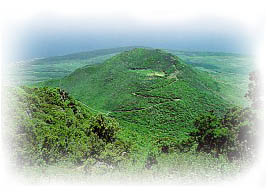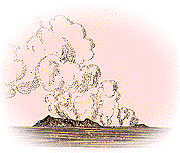Geology of Pantelleria(by Capt. Dr. Marco Belogi, geologist, Military Geographical
Institute of Florence)
The island of Pantelleria is situated 70
km
from the African coast and 85 km from Sicily. Its area is circa 83 sq. Km, the height at
the highest point is 836 m, the peak of the Montagna Grande (Great Mountain), which
constitutes the emerged part of a volcanic formation elevating at 2000 m over an oceanic
crust of about 20 kms in thickness. The
shape of the island, elongated towards NW on one side and SE on the other, follows the
general direction of the tectonic rift of the Sicilian Channel. The island is exclusively made up of two
kinds of volcanic rocks. One can infact distinguish acid vulcanites (rich in silica) and
basic vulcanites (poor in silica). Acid vulcanites, such as trachite and riolite, rich in
alkalines (sodium and potassiun), constitute 98% of emerged rocks. Because of the
peculiarity, riolite is also known as pantellerite. These rocks are formed by high
viscosity lavae with a high percentage of glass, or by pyroplastic materials (ignimbrites)
deriving from explosive activities. Basic vulcanites constitute 2% of emerged rocks, and
are represented by olivinic basalt and hawaite, which are very fluid and dark
lavae. Thirty to forty eruptive spots have been
detected: cones and domes are characteristic of acid lavae, while parallel cones are of
basic lavae.
Pantelleria’s geological history
can thus be synthesized:
- about 220,000 years ago, extrusion of a
trachitic disc;
- 220,000 to 50,000 years ago, eruptions rich in
silica, which is found especially in the area covered by Kuddia Attalora, on the southern
part of the island; 120,000 years ago, birth of a caldera in the zone of the main volcanic
area; minor basaltic events particularly at Cala dell’Alca;
- 50,000 years ago, emission of so-called green
ignimbrite, which covers an area of 48 sq. Km, with a maximum thickness of 20 m;
following this, collapse of the main volcanic area, creating a caldera;
- 35,000 years ago, inside the caldera, ascent
of the trachitic dome of the Montagna Grande, causing a collapse of the top part and birth
of secondary craters such as Monte Gibele and Kuddia di Mida (made of
pumice);
- about 30,000 years ago, basaltic eruptions NW
of the caldera;
- 22,000 years ago, a spill out of the
endogenous dome of Monte Gelkhammar, which cleaving apart, causes a spill out of riolitic
lavae which reach the sea (punta Fram);
- 16,000 years ago, explosive activities at
Kuddia di Mida;
- 9,000 years ago, emissions of basaltic lavae
at Kuddie Rosse creating formations of waste cones.

The general morphology of the island,
from the above information, is the consequence of four main factors:
- The presence in the central part of the island
of two calderas of different ages;
- The lift of the Montagna Grande
- The presence of faults which make the high
coasts on the southern and eastern parts of the island;
- The basaltic lavaflow on the northwestern part
of the island.
|
